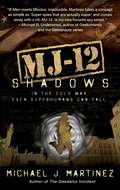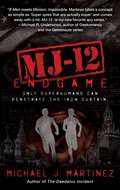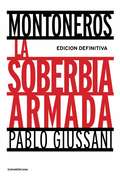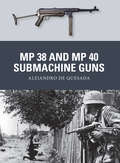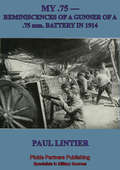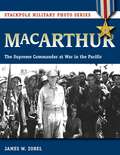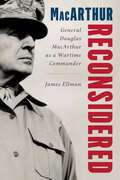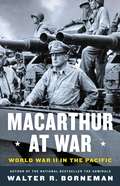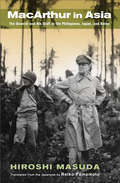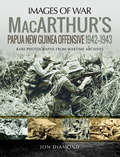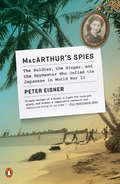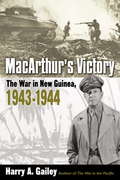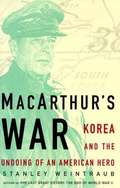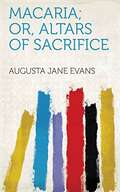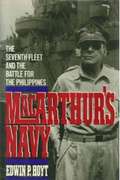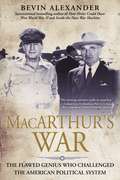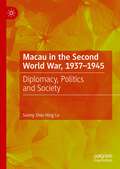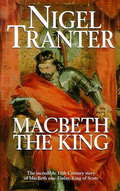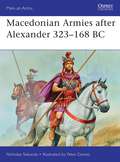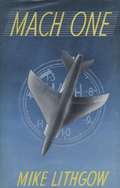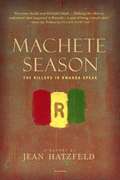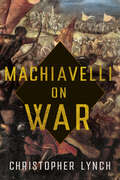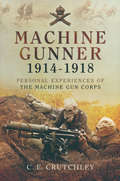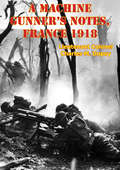- Table View
- List View
MJ-12: A MAJESTIC-12 Thriller (MAJESTIC-12 #2)
by Michael MartinezA team of superhuman spies navigate dangerous global espionage in the sequel to the paranormal historical thriller MJ-12: Inception. It’s 1949, and the Cold War is heating up across the world. For the United States, the key to winning might be Variants—once ordinary US citizens, now imbued with strange paranormal abilities and corralled into covert service by the government’s top secret MAJESTIC-12 program. Some Variants are testing the murky international waters in Syria, while others are back at home, fighting to stay ahead of a political power struggle in Washington. And back at Area 51, the operation’s headquarters, the next wave of recruits is anxiously awaiting their first mission. All the while, dangerous figures flit among the shadows and it’s unclear whether they are threatening to expose the Variants for what they are . . . or to completely destroy them. Are they working for the Soviet Union, or something far worse?
MJ-12: A MAJESTIC-12 Thriller (MAJESTIC-12 #3)
by Michael J. MartinezA Cold War fought by superhuman agents reaches a boiling point in the thrilling finale to the MAJESTIC-12 historical thriller/superhero mash-up series from Michael J. Martinez. Josef Stalin is dead. In the aftermath, the Soviet Union is thrown into crisis, giving former secret police chief Laverentiy Beria exactly the opening he needs. Beria’s plan is to secretly place his country’s Variants—ordinary people mysteriously embued with strange, superhuman powers—into the very highest levels of leadership, where he can use them to stage a government coup and seize control of the USSR. America's response comes from its intelligence communities, including the American Variants recruited for the top-secret MAJESTIC-12 program, who are suddenly thrown into their most dangerous and important assignment yet. From the halls of the Kremlin to the battlefields of Korea, superpowered covert agents face off to determine the future of the planet—a future their very existence may ultimately threaten.
MONTONEROS, LA SOBERBIA ARMADA (EBOOK)
by Pablo C. GiussaniPablo Giussani escribió Montoneros. La soberbia armada en Italia, adonde emigró a fines de los 70 para proteger la vida de su familia. Quería contar su visión sobre la organización político militar de la cual había estado cerca, pero que nunca había integrado, a diferencia de muchos de sus amigos, como Francisco Paco Urondo, Juan Gelman, Rodolfo Walsh o Miguel Bonasso. Su trabajo tenía como objetivo entender de dónde venían los rituales de aquel grupo que por entonces estaba diezmado tras la represión salvaje y el exilio de algunos de sus miembros. A mediados de 1982 el manuscrito estaba terminado. Ernesto Sabato, Daniel Divinsky, Raúl Alfonsín y Jacobo Timerman fueron algunos de los lectores iniciales que, entusiasmados, lo promovieron entre editores argentinos. Finalmente, propuesto por Sabato, Sudamericana Planeta lo publicó en marzo de 1984. Se convirtió de inmediato en uno de los best sellers del año. Con el libro se desató la polémica y el debate. El autor avanzaba hasta lugares a los que no se había llegado antes y, paradójicamente, tampoco se llegaría después, como comparar a los guerrilleros argentinos con los fascistas italianos en su culto a la muerte. Montoneros. La soberbia armada fue reeditado una y otra vez y sigue siendo bibliografía ineludible para los numerosos trabajos publicados sobre la violencia política de los años 70. Giussani imaginaba, hace más de un cuarto de siglo, al concluirlo, que los Montoneros terminarían siendo olvidados y que nadie en el futuro se atrevería a reivindicarlos. En esto se equivocó. Y por eso su libro sigue vigente como en el primer día.
MP 38 and MP 40 Submachine Guns
by Alejandro De QuesadaNazi Germany's MP 38 and MP 40 submachine guns are among World War II's most iconic weapons, but it is often forgotten that they continued in use all over the world for many decades after 1945, even being seen during the fighting in Libya in 2011. Widely issued to Fallschirmjäger (parachute infantry) owing to their portability and folding stocks, the MP 38 and MP 40 became the hallmarks of Germany's infantry section and platoon leaders; by the war's end the Germans were following the Soviet practice of issuing entire assault platoons with submachine guns. Over 1 million were produced during World War II, many finding their way after 1945 into the hands of paramilitary and irregular forces, from Israel to Vietnam; the Norwegian armed forces continued to use them until the early 1990s, and examples and derivatives saw widespread use in the Yugoslav wars of that decade. The submachine-gun concept had its origins in the trenches of World War I, as German designers sought to develop a new weapon that utilized pistol ammunition to deliver devastating bursts of automatic fire at close ranges. The massively influential Bergmann MP 18, the world's first purpose-built 'machine pistol' (submachine gun), spearheaded the German assaults of 1918 and, although the Treaty of Versailles banned the study and manufacture of light automatic weapons in Germany, weapons designers like Berthold Geipel and Heinrich Vollmer of Erfurter Maschinenfabrik (Erma) covertly continued to innovate in this field.An open-bolt, blowback-operated weapon with a single-feed 32-round magazine offering fully automatic fire only and a patented telescoping return spring guide that served as a pneumatic recoil buffer, Geipel and Vollmer's MP 38 drew upon earlier prototypes such as the VMP 1930 and MP 36, as well as the EMP 35, another Erma design that was widely exported and saw combat in the Spanish Civil War. The MP 38 was one of the first of the lighter, more compact "second generation" of submachine guns, utilizing stamped-steel and plastic components that made it easier to produce than earlier types such as the M1928 Thompson and the MP 18, which featured wooden stocks and employed machined-steel parts. It was rapidly adopted by Germany's armed forces and first saw combat during the invasion of Poland in 1939. An improved version, the MP 40, made greater use of stamped steel and electro-spot welding to simplify production further; a twin-magazine version, the MP 40/II, was briefly and unsuccessfully considered as a counter to the select-fire Soviet PPSh-41 with its 71-round drum magazine.The MP 38 and the MP 40 saw combat in the hands of German troops in every theater in which they were involved, and have become synonymous with Nazi Germany's war effort in popular perception. Even during the war Geipel and Vollmer's designs, mistakenly attributed to the rival designer Hugo Schmeisser by the Allies, profoundly influenced the British Sten and the US M3 "grease gun" as well as postwar weapons such as the Spanish Star Modelo Z-45 and the Yugoslav M56. Featuring specially commissioned full-color artwork and period and close-up photographs, this is the story of the origins, combat use, and lasting influence of two of World War II's most famous firearms.
MY .75 —Reminiscences Of A Gunner Of A .75 Mm. Battery In 1914
by Anon. Paul LintierThe renowned military correspondent of the Times Cyril Falls awarded this memoir two of his coveted stars (of three stars possible) and described it as follows:"** - Paul Lintier, a young field artilleryman doing his service when war broke out, kept a journal until the 22nd September when he was wounded, which is among the finest documents of its kind ever published. He is one of the few writers whose powers of description and of self-analysis are equally great. His battery was in the French IV Corps, and took part in the disastrous action of Virton. The details of the defeat, the pictures of the shaken infantry and of the roads blocked by fleeing country people, are wonderfully good. But defeat was not to be his sole experience. The exhausted battery was suddenly entrained with its division and moved through Paris to the left flank, where it formed part of General Maunoury's Army, and on the 9th September for the first time "got its own back" firing over open sights upon the enemy in mass. Then came the wild joy when it was discovered that the enemy had broken off the action. The advance to the Aisne followed. Just before Lintier was wounded there was another desperate action, in the course of which the battery was firing at a range of 800 metres. On returning to the front Lintier kept another journal, which was found on his body when he fell in action."--Cyril Falls, War Books, London 1930.
MacArthur (Stackpole Military Photo Series)
by James W. ZobelGeneral Douglas MacArthur was one of the most colorful, controversial, and image-conscious military figures of the twentieth century. This military biography in photos captures the spirit of the man and his legend in hundreds of historical images.
MacArthur Reconsidered: General Douglas MacArthur as a Wartime Commander
by James EllmanJames Ellman digs deep, connects the dots, and concludes that General Douglas MacArthur was decidedly not a military genius.One of America's most controversial generals, Douglas MacArthur&’s rise through the U.S. Army&’s ranks was meteoric. However, he did not lead large formations of men in combat until he assumed command of forces in the Philippines in 1941. When war commenced with the bombing of Pearl Harbor, MacArthur&’s performance on the battlefield was a failure: he underestimated the Japanese, and his poorly trained forces were outmaneuvered and outfought by a much smaller invading force. However, in what became a repeating hallmark of his career, he successfully portrayed his actions to much of the American people as brilliant and heroic regardless of victory or defeat. After fleeing to Australia, MacArthur famously announced, &“I will return,&” and followed through on a quest to retake Manila regardless of its impact on Allied global strategy or its cost in American, Australian, and Filipino blood.In his subsequent role as America&’s shogun in Tokyo, MacArthur was again surprised by an enemy he underestimated. The Korean War yielded his greatest victory, at Inchon, but also his greatest defeat, along the Yalu River. Unwilling to accept anything but complete victory, he openly defied President Truman: MacArthur fatally undermined chances for an early peace, planned to seed a great swath of enemy territory with radioactive cobalt, and attempted to widen a conflict which threatened to become a third world war. Raging against his subsequent firing, he only truly faded away after he was publicly criticized by a panoply of America&’s greatest WWII generals.Today, MacArthur still polarizes. Many biographies agree he was a great and patriotic leader marred by a few failures. Ellman argues the opposite: MacArthur was a lackluster battlefield commander who suffered stunning defeats while undermining the command structure of our military.
MacArthur at War: World War II in the Pacific
by Walter R. BornemanThe definitive account of General Douglas MacArthur's rise during World War II, from the author of the bestseller The Admirals.World War II changed the course of history. Douglas MacArthur changed the course of World War II. MACARTHUR AT WAR will go deeper into this transformative period of his life than previous biographies, drilling into the military strategy that Walter R. Borneman is so skilled at conveying, and exploring how personality and ego translate into military successes and failures.Architect of stunning triumphs and inexplicable defeats, General MacArthur is the most intriguing military leader of the twentieth century. There was never any middle ground with MacArthur. This in-depth study of the most critical period of his career shows how MacArthur's influence spread far beyond the war-torn Pacific.
MacArthur in Asia: The General and His Staff in the Philippines, Japan, and Korea
by Hiroshi Masuda Reiko YamamotoGeneral Douglas MacArthur's storied career is inextricably linked to Asia. His father, Arthur, served as Military Governor of the Philippines while Douglas was a student at West Point, and the younger MacArthur would serve several tours of duty in that country over the next four decades, becoming friends with several influential Filipinos, including the country's future president, Emanuel L. Quezon. In 1935, he became Quezon's military advisor, a post he held after retiring from the U.S. Army and at the time of Japan's invasion of 1941. As Supreme Commander for the Southwest Pacific, MacArthur led American forces throughout the Pacific War. He officially accepted Japan's surrender in 1945 and would later oversee the Allied occupation of Japan from 1945 to 1951. He then led the UN Command in the Korean War from 1950 to 1951, until he was dismissed from his post by President Truman.In MacArthur in Asia, the distinguished Japanese historian Hiroshi Masuda offers a new perspective on the American icon, focusing on his experiences in the Philippines, Japan, and Korea and highlighting the importance of the general's staff-the famous "Bataan Boys" who served alongside MacArthur throughout the Asian arc of his career-to both MacArthur's and the region's history. First published to wide acclaim in Japanese in 2009 and translated into English for the first time, this book uses a wide range of sources-American and Japanese, official records and oral histories-to present a complex view of MacArthur, one that illuminates his military decisions during the Pacific campaign and his administration of the Japanese Occupation.
MacArthur's Papua New Guinea Offensive, 1942–1943 (Images of War)
by Jon Diamond Dr.&“A compelling chronicle of the Battle of Papua New Guinea with rarely viewed images from World War II . . . an excellent book.&” —Naval Historical Foundation The Japanese seizure of Rabaul on New Britain in January 1942 directly threatened Northern Australia and, as a result, General Douglas MacArthur took command of the Southwest Pacific Area. In July 1942, the Japanese attacked south across the Owen Stanley mountain range. Thanks to the hasty deployment of Australian militiamen and veteran Imperial Force troops the Japanese were halted at Ioribaiwa Ridge just 27 miles from Port Moresby. MacArthur&’s priority was to regain Northeast New Guinea and New Britain. The capture of airfields at Buna and reoccupation of Gona and Sanananda Point were prerequisites. The Allied offensive opened on 16 November 1942 with Australian infantrymen and light tanks alongside the US 32nd Infantry Division. Overcoming the Japanese and the inhospitable terrain in tropical conditions proved the toughest of challenges. It remains an achievement of the highest order that the campaign ended successfully on 22 January 1943. This account with its clear text and superb imagery is a worthy tribute to those who fought and, all too often, died there.&“Covers a seriously neglected key campaign of WWII. Most Highly Recommended.&” —Firetrench&“A fascinating look at real jungle warfare and the images only accentuate how miserable troops must have been during the fighting.&” —ModelingMadness.com
MacArthur's Spies: The Soldier, the Singer, and the Spymaster Who Defied the Japanese in World War II
by Peter Eisner"MacArthur's Spies reads like Casablanca set in the Pacific, filled with brave and daring characters caught up in the intrigue of war—and the best part is that it's all true!" —Tom Maier, author of Masters of SexA thrilling story of espionage, daring and deception set in the exotic landscape of occupied Manila during World War II. On January 2, 1942, Japanese troops marched into Manila unopposed by U.S. forces. Manila was a strategic port, a romantic American outpost and a jewel of a city. Tokyo saw its conquest of the Philippines as the key in its plan to control all of Asia, including Australia. Thousands of soldiers surrendered and were sent on the notorious eighty-mile Bataan Death March. But thousands of other Filipinos and Americans refused to surrender and hid in the Luzon hills above Bataan and Manila. MacArthur's Spies is the story of three of them, and how they successfully foiled the Japanese for more than two years, sabotaging Japanese efforts and preparing the way for MacArthur’s return. From a jungle hideout, Colonel John Boone, an enlisted American soldier, led an insurgent force of Filipino fighters who infiltrated Manila as workers and servants to stage demolitions and attacks. “Chick” Parsons, an American businessman, polo player, and expatriate in Manila, was also a U.S. Navy intelligence officer. He escaped in the guise of a Panamanian diplomat, and returned as MacArthur’s spymaster, coordinating the guerrilla efforts with the planned Allied invasion. And, finally, there was Claire Phillips, an itinerant American torch singer with many names and almost as many husbands. Her nightclub in Manila served as a cover for supplying food to Americans in the hills and to thousands of prisoners of war. She and the men and women who worked with her gathered information from the collaborating Filipino businessmen; the homesick, English-speaking Japanese officers; and the spies who mingled in the crowd. Readers of Alan Furst and Ben Macintyre—and anyone who loves Casablanca—will relish this true tale of heroism when it counted the most.
MacArthur's Victory: The War in New Guinea, 1943-1944
by Harry A. GaileyA GREAT WARRIOR AT THE PEAK OF HIS POWERS. In March 1942, General Douglas MacArthur faced an enemy who, in the space of a few months, captured Malaya, Burma, the Philippines, the Dutch East Indies, and, from their base at Raubaul in New Britain, threatened Australia. Upon his retreat to Australia, MacArthur hoped to find enough men and matériel for a quick offensive against the Japanese. Instead, he had available to him only a small and shattered air force, inadequate naval support, and an army made up almost entirely of untried reservists. Here is one of history's most controversial commanders battling his own superiors for enough supplies, since President Roosevelt favored the European Theater; butting heads with the Navy, which opposed his initiatives; and on his way to making good his promise of liberating the Philippines. In the battles for Buna, Lae, and Port Moresby, the capture of Finschhafen, and other major actions, he would prove his critics wrong and burnish an image of greatness that would last through the Korean War. This was the "other" Pacific War: the one MacArthur fought in New Guinea and, against all odds and most predictions, decisively won.
MacArthur's War: Korea and the Undoing of an American Hero
by Stanley WeintraubA careful analysis of the events which led up to General MacArthur's removal from command.
Macaria: or, Altars Of Sacrifice (Library of Southern Civilization)
by Drew Gilpin Faust Augusta Jane EvansFirst published in 1864, Macaria; or, Altars of Sacrifice was the third novel of Augusta Jane Evans, one of the leading women writers of nineteenth-century domestic fiction. A wartime best seller, with more than twenty thousand copies in circulation in the print-starved Confederacy before the war’s end, the novel was also extremely well received along the Union front, so much so that some northern officials thought it should be banned. Long out of print and largely unavailable until now, Macaria is a compelling narrative about women and war. <p><p> In Macaria, Evans charts the journey of two southern women toward ultimate self-realization through their service in the war-torn Confederacy. Discarding the theme of romantic fulfillment, Evans skillfully crafts a novel about women compelled by the departure and death of so many southern men to find meaning in their own “single blessedness,” rather than in marriage. <p><p> Drew Gilpin Faust, in her perceptive introduction to this edition, places the novel in the context of the concerns of Confederate nationalism and the contributions of women during the Civil War. She provides an ideological and historical framework within which to interpret the novel and introduce it to a new generation of readers. Largely overlooked in the current revival of women’s fiction, Augusta Jane Evans is less well known today than she should be. The reissue of this volume will do much to garner Evans a well-deserved place in the existing body of American literature, and especially southern and women’s literature.
Macarthur's Navy: The Seventh Fleet and the Battle for the Philippines
by Edwin P. HoytThe seventh fleet and the battle for the Phillipines.
Macarthur's War
by Bevin AlexanderGeneral Douglas MacArthur was highly skilled and world famous as a military commander. Under his leadership after World War II, Japan was rebuilt into a democratic ally. But during the Korean War, in defiance of President Harry S. Truman and the Joint Chiefs of Staff, he pushed for an aggressive confrontation with Communist China--a position intended to provoke a wider war, regardless of the consequences. While MacArthur aspired to stamp out Communism across the globe, Truman was much more concerned with containing the Soviet Union. The infamous clash between them was not only an epic turning point in history, but the ultimate struggle between civil and military power in the United States. While other U.S. generals have challenged presidential authority, no other military leader has ever so brazenly attempted to dictate national policy. In MacArthur's War, Bevin Alexander details MacArthur's battles, from the alliances he made with Republican leaders to the threatening ultimatum he delivered to China against orders--the action that led directly to his downfall. INCLUDES PHOTOGRAPHS
Macau in the Second World War, 1937-1945: Diplomacy, Politics and Society
by Sonny Shiu-Hing LoThis book offers a re-interpretation of the political history of Macau from 1937 to 1945, during which Japan and China were engulfed in the Second World War. Using an array of English and Chinese sources, the author explores the diplomatic and social landscape of war-time Macau under Portuguese colonial rule. By framing this analysis within the concept of Portuguese ‘neutrality’, the book builds on the political history of Macau and provides new insights into the role of Japanese collaborators and Communist guerrillas. Seeking to answer important questions such as why Macau was not invaded by Japan in the Second World War, and what role the Nationalist Party Government played during this period, this book presents a new approach to examining Macau’s diplomatic history. A unique read for scholars of Chinese history, this book will also appeal to those researching diplomatic and political history during the Second World War.
Macbeth the King
by Nigel TranterAcross a huge colourful canvas, ranging from the wilds of Scotland toNorway, Denmark and Rome, here is the story of the real MacBeth.Set aside Shakespeare's portrait: read instead of his struggle to makeand save a united Scotland.In this impressively researched and vivid portrayal, Tranter belies thepopular perception of a savage, murderous ambitious king. Instead, hetells of MacBeth's struggle to make and save a united Scotland; hisdevotion to his great love, the young Queen Gruoch; the humane laws theyfought for; the great battle they were forced to fight. And the terribleprice they paid.
Macbeth the King
by Nigel TranterAcross a huge colourful canvas, ranging from the wilds of Scotland toNorway, Denmark and Rome, here is the story of the real MacBeth.Set aside Shakespeare's portrait: read instead of his struggle to makeand save a united Scotland.In this impressively researched and vivid portrayal, Tranter belies thepopular perception of a savage, murderous ambitious king. Instead, hetells of MacBeth's struggle to make and save a united Scotland; hisdevotion to his great love, the young Queen Gruoch; the humane laws theyfought for; the great battle they were forced to fight. And the terribleprice they paid.
Macedonian Armies after Alexander 323-168 BC
by Peter Dennis Nicholas SekundaThe death of Alexander the Great in 323 BC threw the Macedonians into confusion; there was no capable heir, and no clear successor among the senior figures in Alexander's circle. Initial attempts to preserve the unity of Alexander's conquests gave way to a period of bloody and prolonged warfare. For well over a century the largely mercenary armies of Alexander's successors imposed their influence over the whole of the Near East, while absorbing local military practices. After Rome's decisive defeat of Carthage in 202 BC, Macedonia came under increasing pressure from the Romans. Three wars between the two powers culminated in the Roman victory at Pydna in 168 BC, which laid Alexander's empire to rest and established Roman hegemony in the Near East. Drawing upon a wide array of archaeological and written sources and written by a noted authority on the Hellenistic period, this survey of the organization, battle history and appearance of the armies of Alexander's successors is lavishly illustrated with specially commissioned full-colour artwork.
Mach One
by Mike LithgowMike Lithgow joined the Fleet Air Arm in 1939. A year later he was flying from the deck of the ill-fated carrier Ark Royal.Lithgow flew in the attack which sank the Bismarck, and later was in the search for the Tirpitz. While on patrol in the South Atlantic his plane flew into the sea and he and his crew were left floating in their Mae Wests eight hundred miles from the nearest land...their rescue can only be described as miraculous.In 1945 Lithgow became a test pilot with Vickers Supermarine organisation; since 1948 he has been Chief Test Pilot.In his brilliant career with Vickers, Lithgow has flown the world demonstrating the prowess of that wonderful aircraft, the Swift, and its succeeding prototype, F525. His story is entertaining, intensely readable, and revealing of a very brave man.
Machete Season: A Report
by Linda Coverdale Jean HatzfeldDuring the spring of 1994, in a tiny country called Rwanda, some 800,000 people were hacked to death, one by one, by their neighbors in a gruesome civil war. This book is a report by journalist Jean Hatzfeld, who traveled to Rwanda several years later, to interview ten participants in the killings, eliciting extraordinary testimony from these men about the genocide they perpetrated.
Machiavelli on War
by Christopher LynchMachiavelli on War offers a comprehensive interpretation of the philosopher-historian's treatment of war throughout his writings, from poems and memoranda drafted while he was Florence's top official for military matters to his posthumous works, The Prince and Discourses on Livy. Christopher Lynch argues that the issue of war permeates the form and content of each of Machiavelli's works, the substance of his thoughts, and his own activity as a writer, concluding that he was the first great modern philosopher because he was the first modern philosopher of war.Lynch details Machiavelli's understanding of warfare in terms of both actual armed conflict and at the intellectual level of thinkers competing on the field of knowledge and belief. Throughout Machiavelli's works, he focuses on how military commanders' knowledge of human necessities, beginning with their own, enables and requires them to mold soldiers, organizationally and politically, to best deploy them in operations attuned to political context and changing circumstances. Intellectually, leaders must shape minds, their own and others', to reject beliefs that would weaken their purpose; for Machiavelli, this meant overcoming the classical and Christian traditions in favor of a new teaching of human freedom and excellence. As Machiavelli on War makes clear, prevailing both on the battlefield and in the war of ideas demands a single-minded engagement in "reasoning about everything," beginning with oneself. For Machiavelli, Lynch shows, the successful military commander is not just an excellent leader but also an excellent human being in constant pursuit of the truth about themselves and the world.
Machine Gunner, 1914–18: Personal Experiences of the Machine Gun Corps
by C. E. CrutchleyIn 1914 there were only two machine guns supporting a British infantry battalion of 800 men, and in the light of the effectiveness of German and French machine guns the Machine Gun Corps was formed in October 1915. This remarkable book, compiled and edited by C E Crutchley, is a collection of the personal accounts of officers and men who served in the front lines with their machine guns in one of the most ghastly wars, spread over three continents. The strength of the book lies in the fact that these are the actual words of the soldiers themselves, complete with characteristic modes of expression and oddities of emphasis and spelling. All theatres of war are covered from the defence of the Suez Canal, Gallipoli and Mesopotamia in the east to France and Flanders, the German offensive of March 1918 and the final act on the Western Front that brought the war to an end. October 2006 is the 90th anniversary of the formation of the Machine Gun Corps.
Machine Gunner’s Notes, France 1918 [Illustrated Edition]
by Lieutenant Colonel Charles M. DupuyIncludes The Americans in the First World War Illustration Pack - 57 photos/illustrations and 10 mapsWhen the United States entered the First World War in 1917 the size of the army was tiny in comparison to the European Powers. The long-serving officers of the U.S. army faced the daunting task of licking the new recruits of 1917 into shape for service overseas. Among these officers was Charles Dupuy who was charged with getting his men ready for battle utilising the weapon that had inflicted so much damage during the previous three years - the machine gun. Key to offence or defence, the machine gun companies of the U.S. expeditionary force had to be fast and deadly in the offence and staunch and steadfast in defence. Major Dupuy tells of how he whipped his men into shape and led them to hard fought victory against the Germans on the Western front in 1918.
